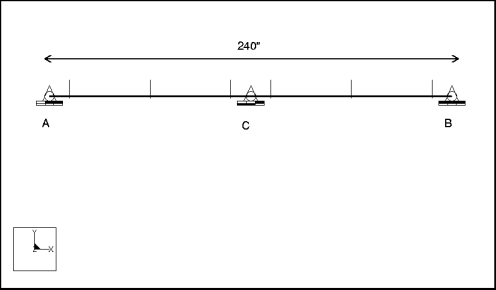
|
Analysis Type:
|
Dynamic Shock
|
|
Model Type:
|
3D
|
|
Comparison:
|
ANSYS No. 70
|
|
Reference:
|
Biggs, J. M. Introduction to Structural Dynamics. McGraw-Hill Book Co., New York, 1964.
|
|
Description:
|
A simply supported beam is subjected to a vertical motion of both supports. The motion is defined in terms of a seismic displacement response spectrum. Determine the maximum displacement and the corresponding maximum bending stress.
|

Element Type: | beam (2) | ||
Units: | IPS | ||
Dimensions: | length: 240 height: 14 | ||
Beam Properties: | Area: 273.9726 IYY: 333.333 Shear FY: 0.83333 CY: 7 | J: N/A IZZ: 333.333 Shear FZ: 0.83333 CZ: 7 | |
Material Properties: | Mass Density: 0.00073 Cost Per Unit Mass: 0 Young's Modulus: 3e7 | Poisson's Ratio: 0.3 Thermal Expansion: 0 Conductivity: 0 | |
Constraints: | Location: | Degrees of Freedom: | |
constraint1 | placed on point A | fixed in TransY and TransZ | |
placed on point B | fixed in TransX, TransY, TransZ | ||
placed on point C | fixed in TransZ, RotX, RotY | ||
Response Spectrum: | Frequency: | Displacement: | |
resp_spectrum1 | 0 10 | 0.44 0.44 | |
Theory | ANSYS | Structure | % Difference | |
Frequency | 6.0979 | 6.0974 | 6.0953 | 0.04% |
Max. Displacement (m=disp_max) | 0.560 | 0.553 | 0.560 | 0% |
Max. Bending Stress | 20158 | 20156 | 20138 | 0.1% |
Convergence %: 0.0% on Frequency | Max P: 6 | No. Equations: 70 | ||